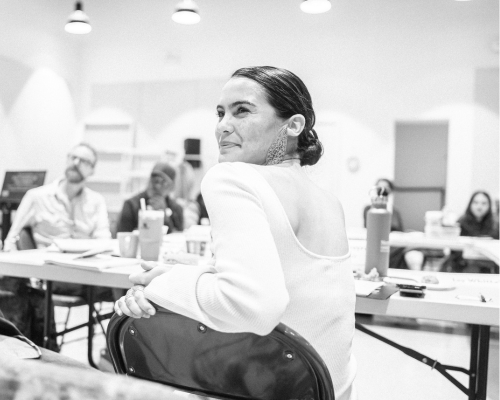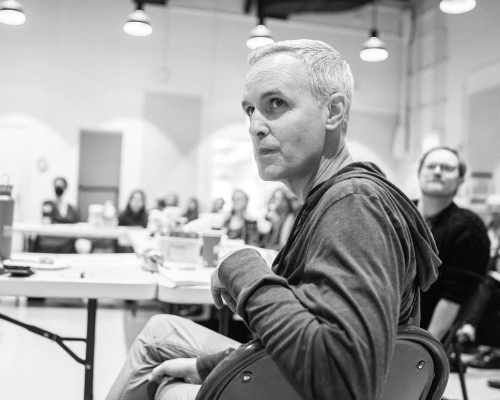In Conversation: Actors Melisa Soledad Pereyra and Jay Whittaker

Few plays in Shakespeare’s canon spark as much debate as The Taming of the Shrew. Celebrated, contested, reimagined, and resisted, this play continues to provoke urgent questions about gender, power, and performance. And director and adaptor Marti Lyons isn’t shying away from them.
Instead, she’s diving headfirst into these themes in her fresh and exciting adaptation that centers feminine desire, consent, control, and play. At the crux of everything are Katherina and Petruchio, two of Shakespeare’s most iconic characters, played by Melisa Soledad Pereyra and Jay Whittaker.
Melisa and Jay recently spoke with Associate Director of Marketing Camille Oswald to reflect on these roles, the history of the production, and the privilege—and responsibility—of staging this play in this moment. What emerges is an invitation to sit with the play’s questions and contradictions—the very things that make this production urgent, alive, and continually worth revisiting. Below is an excerpt of their conversation.
Katherina and Petruchio are arguably some of the most well-known characters in Shakespeare. What has it been like to prepare for two iconic roles?
Jay: I’ve seen four, or maybe five, productions of this play, and it always seems like the productions are apologizing for Petruchio’s behavior—like, the actor playing Petruchio tries to charm the audience and convince them to think, “Oh, he really cares. It’s okay, the way he’s treating her. He’s not a bad guy.” The actors don’t want to be hated by the audience. So I’ve been recalling these moments where I’ve seen other actors charm the audience and play against the language, and that makes me angry. People do that because Petruchio has to be charming in some way for people to enjoy the play, but I think it’s a cop-out. I’ve been trying not to be sucked into those moments and the way that other people have performed [this role].

Melisa: Even a***s have wives! There’s this line from Anna Karenina that says, “If it is true that there are as many minds as there are heads, then there are as many kinds of love as there are hearts.” There is a dynamic for all kinds of people, and we all learn to survive, withstand, or thrive in those dynamics. It depends, on any given day, what that’s going to look like—it’s also contingent upon the people we interact with, the politics we embody, and the politics we encounter—so I feel like that’s the conversation I’m excited to have with this production. That’s where Marti’s job becomes terribly important, in this framing that deals with consent and play. I love Marti’s brain, and finding the right partnership with the director is such a big thing—particularly for this show, which craves analysis and deconstruction and reconstruction. Especially right now, it feels like it would be such a disservice not to try to interpret something, right? Seeking nuance is what we should be trying to do every day in this world that insists on binaries and is always trying to make us choose right or wrong. In my work, lately I’ve been less intrigued by the feeling of, “Oh, my character knows this in their heart.” I used to be really drawn to what they know: they know this, and this is their ethos, and this is how they’re going to walk through life. Now, I’m interested in the not-knowing and the learning.
If you could describe Katherina and Petruchio’s journey in three words, what would they be?
Melisa: There’s a line in King Lear: “See better.” See better—see all the nooks and crannies. So, “See better, Kate.”
Jay: I think, at least now, that for Petruchio, one word can describe the entire journey, and that’s fear. I think he’s terrified. He’s got so many things to be terrified of—the structure of society judging him if he doesn’t win this battle, the powerful force he’s fighting against to win, and then ultimately, the fact that this isn’t something that he can ever win. He’s stuck with constantly trying to be king of the hill.
A lot of this play hinges on the chemistry and tension between Katherina and Petruchio, some of which is fun and flirty, and some of which is harmful and unkind. How do you, as the performer, differentiate between the two?
Jay: Part of the challenge is that we’re going to be performing a play-within-a-play, so we’re not just the characters from the traditional Shakespearean text; effectively, we’re playing two characters. There’s the challenge of finding when those moments are flirty and when they’re harsh, and now there are more additional layers to get through, rather than you’re just playing this guy named Petruchio and this woman named Kate.
Melisa: What I like about this duality is the learning of it and the awareness of it. The instructions that are being given to us (as we play both characters), and how they become part of the system we learn to play within, and how we learn those rules as we go. We’re doing the learning in real time.
In the start of the original text, there is an Induction—effectively, a prologue—where a trick is played on a drunken peasant, Christopher Sly, that leads to a play-within-a-play. This adaptation also begins with a play-within-a-play. Can you tell us about that?
Jay: Christopher Sly gets drunk, passes out, people dress him up as a nobleman, and try to convince him that he’s been crazy and has thought of himself as a poor peasant when, in reality, he’s a rich man. It’s more of a commentary on class—rather than sexual politics—and the dominance of the rich over the poor, which then allows for the larger framework of: here’s a story about dominance between a man and a woman.
People don’t often include the Induction at all, or don’t include it in its entirety. It’s an incisive indictment of class and power, but that can’t be parsed out from the conversation about gender. So what purpose does it serve?

Jay: Totally. And I think if there’s any argument supporting that Shakespeare isn’t using this play to say, “This is how we should treat women,” it’s the Induction, because he’s making a comment on power politics, generally.
Melisa: And it’s called an Induction, not a prologue, so that’s immediately curious to me. It also feels like a different structure. Shakespeare will often just tell you: “Two households, both alike in dignity.” And here, he doesn’t do that. Instead, he’s saying, “Watch this thing. Figure it out.” So in our adaptation, how do we want to say, “Watch this thing. Come with us. Figure it out. Help us put the puzzle together”?
Jay: I do know that the reason it’s called an Induction is very specific to this time period in British drama; there was a fad where playwrights would add these prologues, and it’s only in this very short time that they gave it a different name other than “prologue.” So, Shakespeare got sucked into that fad. I mean, he did steal the entire play. So the Induction was already there in the original play that he stole.
Wait. What?
Jay: It was called The Taming of a Shrew, and he went crazy and called it The Taming of the Shrew. Genius. It was performed for at least a year, I think, before Shakespeare wrote his version.
Looking at the history of the play, it appears that it’s gone through waves of popularity, and its popularity has increased in the 20th and 21st centuries.
Jay: There was a big backlash against [the play], and they would sometimes change it so that Kate came out on top, because there was such backlash to how horribly Petruchio was treating her. People didn’t enjoy that, so they made a new play—was it She Stoops to Conquer?
There’s The Woman’s Prize, or the Tamer Tamed, which was written in 1647? I didn’t realize that it had always been so contentious since its inception.
Melisa: And I think the real question is why? We continue to be in conversation with it, fascinated by it, in argument with it. I think people see The Taming of the Shrew to judge it. We see it so we can decide what we think about it, and then we think that whatever we think about the play is a reflection of our politics and intellect—it just carries so much extra stuff with it. You can look at this play in many ways, but can you get it wrong, per se, if it’s always been wrong? If that’s the case, I’ll be another person who gets it wrong in a long line of people who have gotten it wrong too.
Jay: You’re in good company.
Melisa: The play has too much baggage for us to avoid it. So, let’s do it. It’s a great privilege to be an artist at this time. It’s a great privilege to sit in this conversation, and discuss this play. I know I’m not going to change a legacy of harm. I know I’m not going to change the history of this play by being in it. But my goal is that I get to do this play with all my fears, and all my questions, and all my politics, and all my wrongness. And I won’t take that for granted. We’ll laugh a little, we’ll be sad a little, and we’ll think a little, and I want to resist the numbing that we often feel in trying to survive the world right now. I’m excited. I’m excited by this play and its questions. And whether it’s this play—or whatever play I’m working on—I’m grateful that this is what we do. This is what we get to do for a living.
Experience this bold interpretation of a Shakespearean classic, onstage from November 14 – December 14, 2025. Tickets are available online or by calling the Box Office at (773) 753-4472.